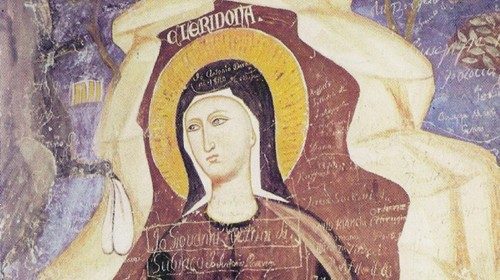
It is August 15, 1676, the feast of the Assumption. Friar Alberto, who is a hermit living isolated in the hinterland of the Gargano, is attending Mass in the Sanctuary of Santa Maria di Stignano and receives Communion. Then, he returns as always, to his cave in the mountains. But, the following Sunday, contrary to his habits, he has not come to the church, so the worried religious go looking for him in the hidden place where the saint prays, does penance, and observes silence. And there they find him dead with the crucifix in his arms, an ecstatic expression on his face, and the open book of prayers in his hands. But, when he is taken for burial to the Saint Augustine hermitage, which is the main structure of the Valley of the Hermitages, they discover an unexpected truth: Brother Albert is not a man but a woman, a woman who had hidden her identity from everyone for 40 years so as to live in contemplation of God without suffering gender discrimination.
Courage, self-sacrifice, a sense of challenge, a faith stronger than conventions and an extreme choice. This is the story of the “woman hermit called Alberto”, a frontier woman of the 17th century, and an exciting example of female hermitry, which has been quite widespread since the origins of Christianity. Among the women who embraced the consecrated life in total isolation in antiquity are: Sofronia of Taranto in the 4th century; the Benedictine Chelidonia in the 12th century, buried in the cathedral of Santa Scolastica in Subiaco; and Donna Geronima de Spinoza who lived in the 17th century. It is thought that some of them had to disguise themselves as men like Alberto the hermit woman, though she is one of the most adventurous. We do not know her name or place of origin, but we do know that “Alberto” belonged to a wealthy family and was probably destined for an arranged marriage. When she presented herself to the friars of Gargano for the “trial” in view of the hermitage, she said that her decision had matured at the funeral of a noblewoman. During the burial in the church, and upon seeing the corpse which had already almost been reduced to dust, she was shaken by a tremor. And she decided to abandon the vanities of the world. One night, so as to avoid her relatives surveillance she rode a horse to Rome where she visited the main basilicas. Then she retired to a hermitage in Abruzzo, near Pacentro. And when her troubled family arrived near her cave three years later, the saint woman was warned of their arrival in a dream by an angel who advised her to take refuge in the mountains above Gargano. For 40 years, Alberto, the woman hermit, lived in disguise in the hermitage of the Annunziata, praying, wearing the cilicium, and flagellating herself. When Friar Guglielmo, the prefect of hermits, went to visit her he was amazed at the harshness of her living conditions, which were unbearable for any human being. But not for a strong woman, who was moved by faith and courage that only extreme choices can provide.
by Gloria Satta













 Purchase the Encyclical here Fratelli Tutti
Purchase the Encyclical here Fratelli Tutti
